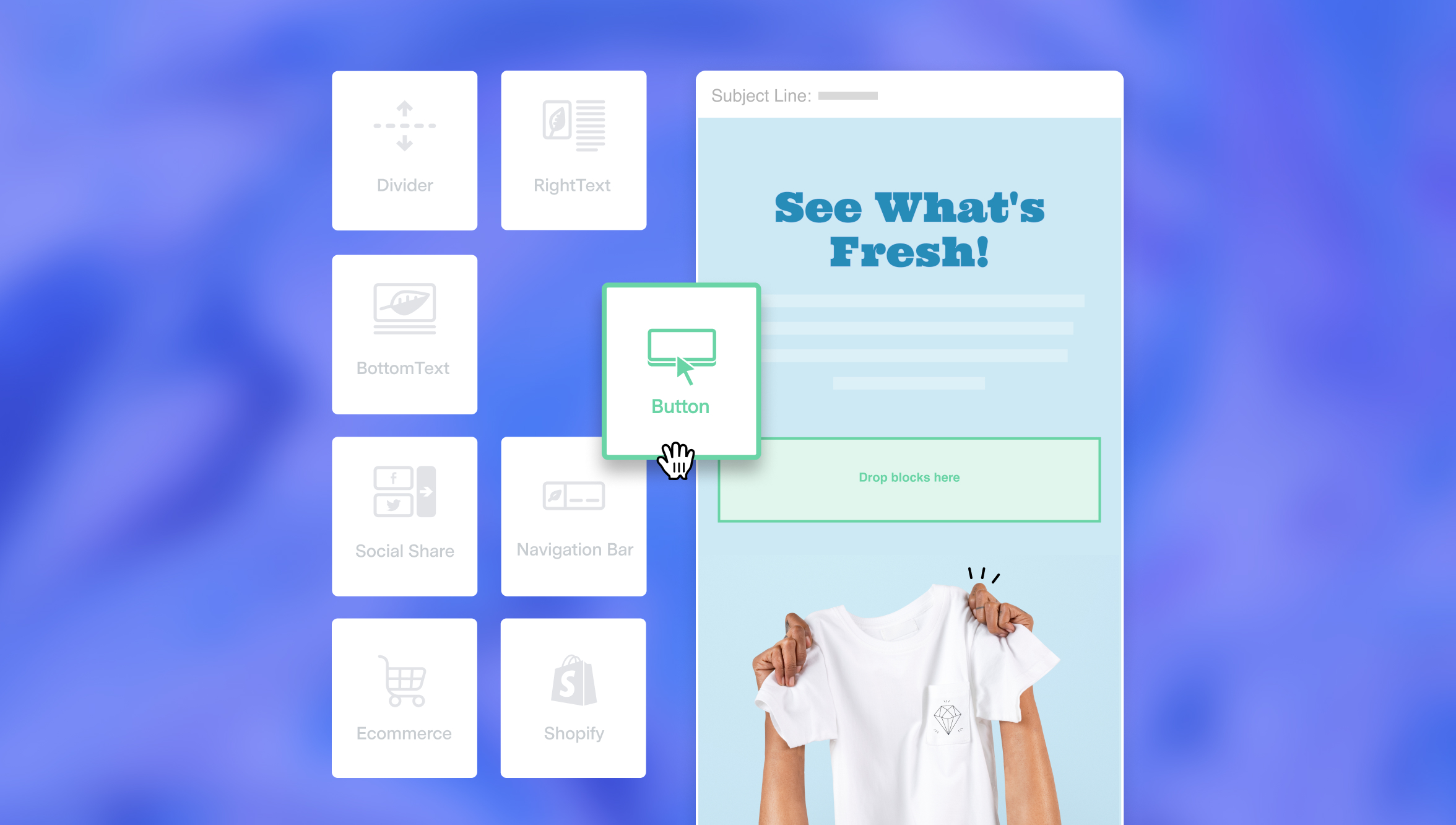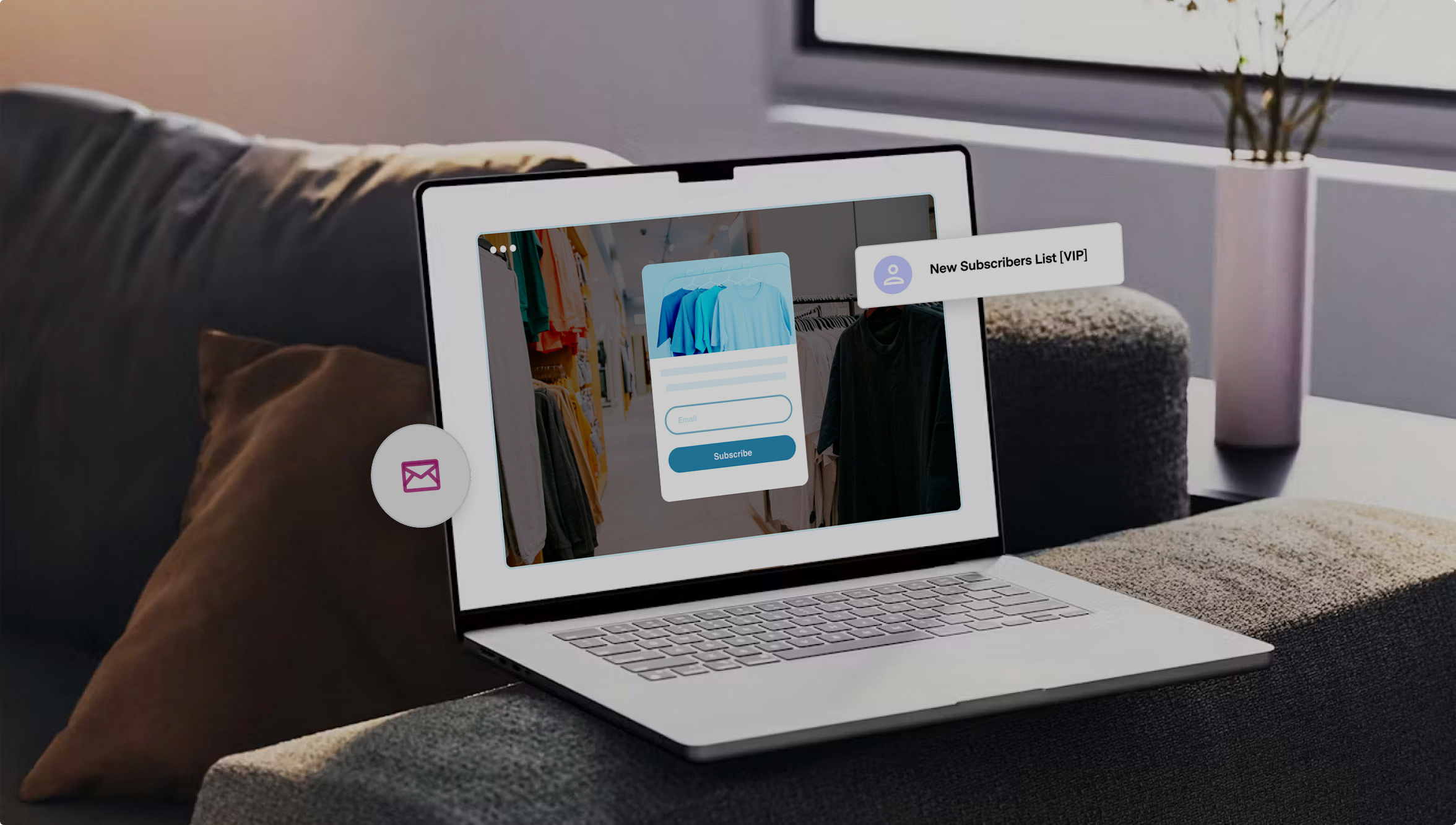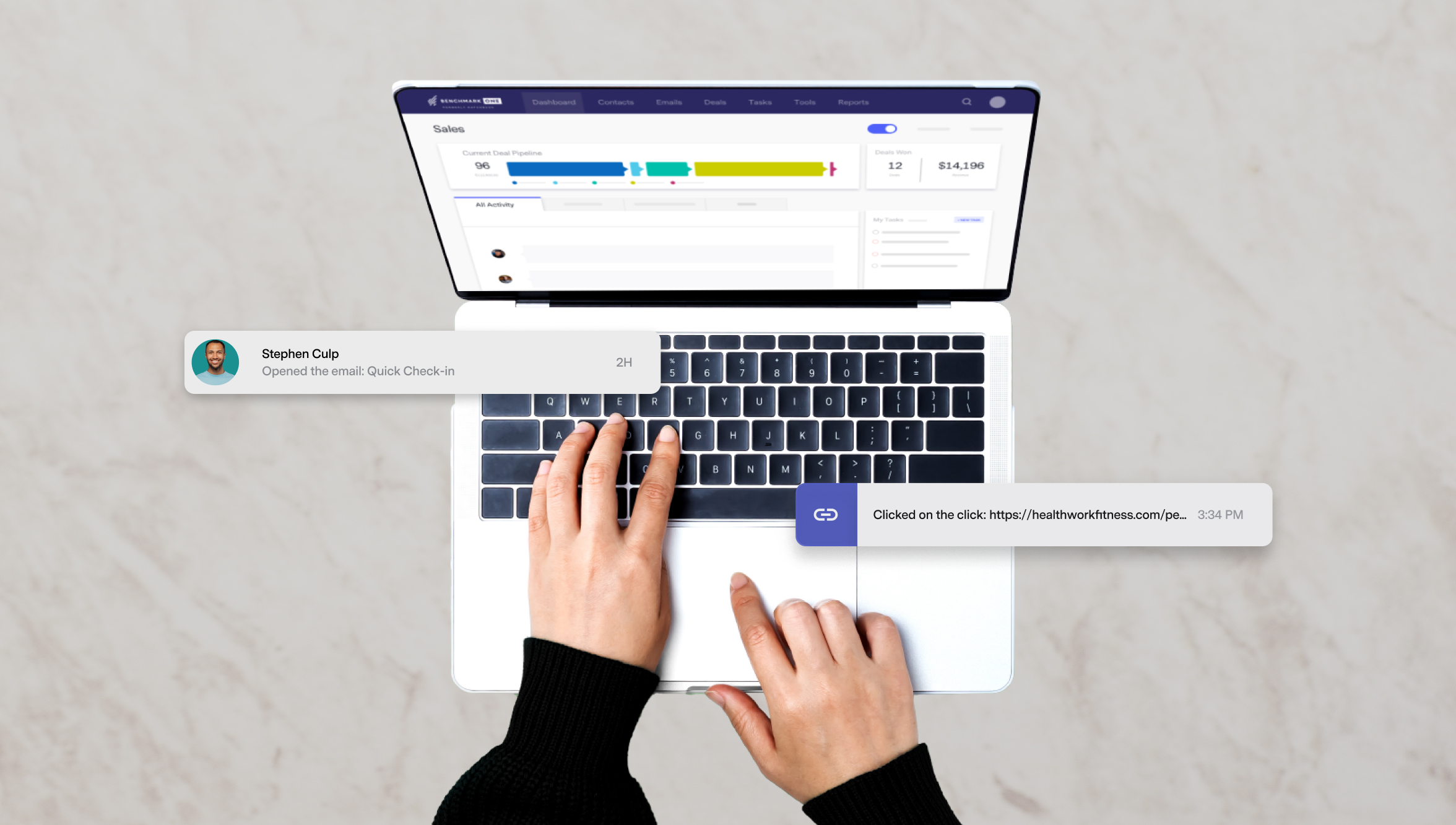Moosend vs tinyEmail vs Benchmark Email: What's Better For Email Marketing In 2024?
I spent two weeks using and testing both Moosend and tinyEmail. In this article, I’ll share my experience with them and their key differences.
Moosend is an all-in-one email marketing platform for engaging with clients, managing contacts, and analyzing customer data.
It’s great for running personalized email campaigns with AI-powered product recommendations and shopping cart abandonment reminders. However, it’s stacked with features that beginners may take longer to get used to. And, its pricing doesn’t adapt well for high-volume senders.
tinyEmail is on the opposite end of the spectrum. It’s a minimalistic tool, designed to handle personalized customer messaging on Shopify stores.
It supports customer communication with its AI-powered messaging tool and does much of the heavy lifting with its pre-built templates. However, its simplicity is also its biggest drawback. That’s because it offers little customizability for reports and automations, and doesn’t include vital email marketing optimization tools like A/B testing and email verification.
Since Moosend is a generalist and tinyEmail is a Shopify specialist, and since both tools don’t cater to high-volume senders too well, I decided to include Benchmark Email in this comparison.
It’s a streamlined solution with a simple email designer, powerful automation, an AI email builder, customer segmentation, and more — all that with great user experience and affordable, scalable pricing. It's an ideal solution for businesses and marketers to run large-volume email campaigns.
In this article, I’ll compare Moosend vs tinyEmail vs Benchmark Email in five key areas:
- Email Builder
- Audience Engagement Tools
- Email Marketing Optimization
- Marketing Automation
- Pricing
Before we go into detail, let’s start with a complete overview of how the three compare in the table below.
Moosend vs tinyEmail vs Benchmark Email: Comparison Summary
Comparison Summary
| Moosend | tinyEmail | Benchmark Email |
|---|---|---|
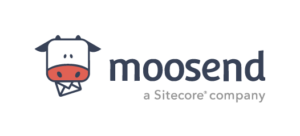 |
 |
 |
| Price | ||
|
30-day free trial. Subscription- and credit-based pricing plans. Subscriptions start at $9/mo for up to 500 subscribers. Offers unlimited emails but gets more expensive with the number of subscribers. |
7-day free trial after which you can opt for the free plan.Pricing plans start at$15/mo for up to 15,000 emails. Doesn’t scale well for large email volume at $2100/mo for 1.5M emails on the Pro plan. |
Offers a free plan. Send-based pricing starts at $39/mo for 10,000 emails and gets cheaper with higher volume. Subscription pricing starts at$15/mo for 7,500 emails. For 1.5M emails, it costs$499/mo. |
| Email Builder | ||
|
Simple, intuitive drag-and-drop email builder with hundreds of templates and a generative AI tool. |
AI-assisted, drag-and-drop email builder with a built-in image editor and customizable templates. |
Lots of email templates and an AI-powered ‘Smart Design’ email generator. Easy-to-use email builder with a built-in image editor and many customization options, including ‘Smart Content’ generator. |
| Audience Engagement | ||
|
Advanced segmentation filters with conditionals. Easy-to-use landing page builder. Lots of form types and customizations. |
Highly customizable segment filters with easy-to-use UI. No landing pages. Limited form options. |
Offers landing pages, signup forms, polls, and surveys. Provides reports on surveys and polls. Includes free contact segmentation tools. |
| Email Marketing Optimization | ||
|
AI-powered product recommendations. Offers lots of pre-built reports and allows custom reports. |
Offers an analytics dashboard with pre-built reports. No custom reports. |
Offers prebuilt reports with social and geo data. It also includes Smart Sending technology, email list verification, and A/B testing. |
| Marketing Automation | ||
|
No automation templates or custom automations. Only offers pre-built automation workflows. |
Advanced automation builder with branching paths, conditional logic, and website tracking. Offers simple email engagement automations. |
Advanced automation builder with branching paths, conditional logic, and website tracking. Offers email engagement automations. |
| Integrations | ||
|
80+ native integrations. |
5+ native integrations and 300+ Zapier integrations. |
30+ native integrations and 1500+ Zapier integrations. |
| Used By | ||
|
Ogilvy, Vogue, Isobar, Dominos, Gucci |
New York University, Suzuki, See’s Candies |
Toyota, Audi, Courtyard Marriott, Canterbury Gardens, Office Depot |
| Best For | ||
|
Running highly personalized email campaigns on small to medium-sized email lists. |
Managing customer messaging and email campaigns on Shopify. |
Creating, managing, optimizing, and sending email campaigns with large email lists. |
|
30-day free trial (no card required) |
7-day free trial (credit card required) |
Try free forever (no card required) |
What is Moosend?
"Elevate your email game, one click at a time!" 

Yannis Psarras and Panos Melissaropoulos are software developers who wanted to make email marketing accessible to everyone. So, in 2011, they founded Moosend as a platform for marketers to engage with clients, manage contacts, and segment and analyze customer data.
Moosend provides an intuitive drag-and-drop email builder with hundreds of customizable templates to design visually appealing emails. It also offers contact segmentation tools and allows users to run automated workflows on segmented lists. To help users understand and optimize their email marketing strategies, Moosend provides detailed analytics and custom reports on metrics like open rates, click-through rates, and conversions, enabling users to optimize campaigns for better results. It also includes other optimization tools like landing pages, A/B testing, and AI-powered personalization.
Moosend personalized product recommendations and powerful analytics make it an excellent choice for eCommerce marketing teams with small to medium-sized email lists.
What is tinyEmail?
"Small but powerful email messaging" 

tinyEmail was created by Seamas and Ann-Maria Egan as a messaging platform for Shopify. Nowadays, it’s become a marketing engine that leverages artificial intelligence to make marketing effortless.
tinyEmail, as the name suggests, contains minimal features. But they’re very powerful, especially when combined with AI-powered content generation. It provides a drag-and-drop email builder with customizable templates. It also includes a fully-featured image editor that helps personalize your content. Although it has somewhat limited marketing automation, tinyEmail provides AI-supported customer segments tailored to your brand. It also lets you create forms with advanced customizations and popup rules. And, you can assess your email campaign performance using pre-built reports.
Even though they extended integrations to other platforms, tinyEmail was designed as an email marketing tool for Shopify and remains the most sensible option for Shopify users. Accordingly, it's free to use for all premium Shopify users.
What is Benchmark Email?
"Connect, Engage, Succeed: Every campaign matters" 

Benchmark Email was created by Curt and Denise Keller in 2004 to help marketers simplify their marketing journey. It is a powerful, yet extremely easy-to-use email marketing and optimization platform.
Benchmark Email provides an intuitive drag-and-drop editor and customizable templates to design eye-catching emails without coding knowledge. The email builder is enhanced by the AI-powered Smart Design, which generates branded emails from your website colors and logos. Benchmark Email allso lets users set up automated email workflows triggered by specific events, such as welcome emails, abandoned cart reminders, and follow-up emails. It allows contact list segmentation based on subscriber behavior, demographics, and preferences to send out personalized content. And, it provides detailed analytics tools that track email performance metrics like open rates, click-through rates, and conversions, enabling users to optimize campaigns for better results.
Benchmark Email is ideal for B2C businesses from various industries, marketing generalists, and other high-volume senders that need a simple but powerful platform for handling large email and subscriber lists.
Moosend vs tinyEmail vs Benchmark Email: Email Builder
| Moosend | tinyEmail | Benchmark Email |
|---|---|---|
|
|
|
|
|
Offers hundreds of templates and advanced personalization. |
Offers fewer templates than Moosend, but uses AI to generate dynamic templates. |
Offers several templates and includes ‘Smart Design’, an AI-powered email generator. |
Moosend offers a drag-and-drop builder with hundreds of email templates.
Moosendoffers a drag-and-drop email editor with unique content options like timers, articles, and even custom HTML blocks. Plus, it provides hundreds of templates to get you started quickly.

It also features email personalization, allowing you to create custom subscriber fields and display information relevant to each recipient. You can also suggest products based on your customer’s previous purchases and remind them of abandoned carts.
tinyEmail offers fewer templates but includes an AI content generator.
tinyEmail also offers a drag-and-drop editor, but it goes an extra step and includes a robust code editor which gives you ultimate control over your content.
To make it easier for you, tinyEmail uses your brand colors and images to create pre-built templates. This way, you can change your brand kit and all your templates automatically update to match the new content.

What’s more, tinyEmail includes a fully-featured image editing studio, allowing you to annotate images with text, stickers, icons, and filters within the same platform. It also lets you insert your products as interactive cards in your emails.
tinyEmail doesn’t offer as many templates as Moosend, but it makes up for it with an AI-powered subject line assistant and email copywriter.

Once you’re satisfied with your design, you can save email sections as modules and reuse them across multiple emails. Any changes to the saved section will be automatically reflected in all your emails.
Benchmark Email offers several templates and an AI-powered content generator.
When using Benchmark Email’s email builder, I found it to have the best user experience of all three.
Unlike most email marketing platforms that use the same third-party builder, Benchmark Email uses a proprietary email editor. Just one of the benefits of this tool, which can’t be found on the other tools, is that you can embed websites like eBay, X (formerly Twitter), and LinkedIn directly in your email.

When adding content to an email, you can organize it into sections — of which you can have an unlimited amount in each email. All sections except the Header and Footer can be reorganized using intuitive Up/Down arrows.
Similar to Moosend, Benchmark Email lets you apply a global style to all sections in your email.
In addition to a custom background color, there are 27 carefully curated color schemes you can choose from. Alternatively, you can use ‘Brand Kit’ to add your own color scheme from your website to the email builder in just a few clicks. To upgrade your design even further, you can then customize section styles individually.

In addition to the desktop and mobile previews, Benchmark Email provides the Test Email feature, which sends your email campaign to any five designated email addresses. This way, you can preview exactly how your emails will appear to subscribers.

It also supports RSS emails, which are automatically sent when you update any linked blog or RSS feed. And, like tinyEmail, it includes a built-in image editor that lets you enhance images with effects, stickers, text, and more.
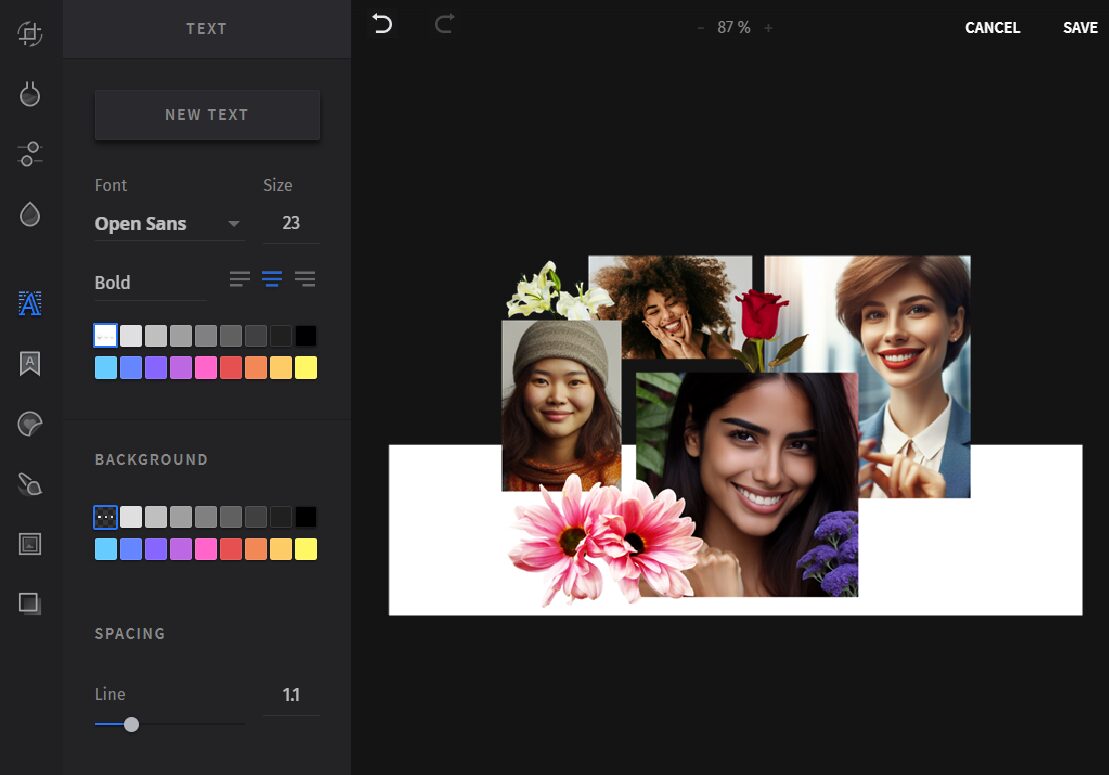
There are also hundreds of email templates available to get you started quickly, and you can even cut down email building time with saved content blocks that you can reuse across multiple emails.
What's more, Benchmark Email also includes an AI-powered Smart Content available to get you started quickly, and you can even cut down email building time with saved content blocks that you can reuse across multiple emails.

Winner: Benchmark Email is extremely easy to use and gives you the tools to create any email imaginable. It also includes customization and branding options, an image editor, several templates, and an AI copywriting assistant. If you need the best email builder, Benchmark Email is the platform for you.
Moosend vs tinyEmail vs Benchmark Email: Audience Engagement Tools
| Moosend | tinyEmail | Benchmark Email |
|---|---|---|
|
|
|
|
|
|
|
|
|
Offers landing pages and subscription forms. Includes robust segmentation tools. |
Offers only web forms. Includes AI-recommended segmentation. |
Offers landing pages, web forms, surveys, and polls. Also includes segmentation. |
Forms and Landing Pages: All three platforms offer web forms, Moosend and Benchmark Email go a step further with landing pages, and only Benchmark Email offers Surveys and Polls.
Moosend provides a drag-and-drop builder for creating engaging landing pages within minutes.
It uses the same HTML designer as the email builder, allowing for a seamless, intuitive workflow. And, you get lots of fully customizable templates to save time and add a personal touch to your campaigns.

Not only are the landing pages responsive across multiple devices, they also feature ultrafast loading times, thanks to Moosend’s content delivery network that puts your email content in many places at once.
To get even more customizations, you can add custom Javascript tools and widgets not included in the editor. Plus, the WordPress plugin lets you host landing pages on your WordPress website.
In addition to landing pages, Moosend also lets you create up to 6 types of embeddable subscription forms:
- inline,
- modal pop-up,
- fullscreen,
- floating bar,
- floating box,
- and promotion pop-up.
Let’s move on to tinyEmail, which doesn’t include landing pages, but you can create embedded, popup, and flyout forms. You also get ready-to-use templates that you can customize to your needs.

Constant Contact forms are fully customizable. You can set the form title and description, and add as many custom fields as you want. In addition, it lets you display the form on a timer or when the visitor moves to exit the tab.
tinyEmail also lets you choose the right time to show forms.
You can set them to display when the page loads, sometime after the page loads, or when the page has been scrolled to a set percentage. Unlike Moosend and Benchmark Email, you can create custom triggers for displaying popups using JavaScript code.

All changes you make to a published form appear instantly on the site. This way, you don’t have to manually embed the updated form on all your web pages anytime you make a change.
Benchmark Email approaches lead generation with the same basic types of forms as tinyEmail but takes it even further with a Small Embed Form type that can fit into page headers and footers. However, they can only collect first names, last names, and emails.
Furthermore, Benchmark Email is the only platform that lets you run surveys and polls.
A poll is a single multiple-choice question about a specific topic that shows the answer ratios upon submission.

On the other hand, surveys are used for more comprehensive feedback.
They allow multiple questions and offer options for detailed answers. After the survey is completed, you get individual, overview, and detailed reports on audience responses to your surveys.
Along with all the mentioned features, Benchmark Email also lets you create dedicated landing pages.
It uses the same drag-and-drop builder as the email designer, but also includes content blocks that let you create custom layouts. Furthermore, you can choose which email content to hide or show on mobile and desktop devices.

Segmentation:
All three platforms offer contact segmentation, but only Benchmark Email offers it on the free plan.
Moosend lets you create simple segmentation filters based on customer demographic information like age and location. Or, you can create advanced filters based on past purchases, number of times a product is viewed, device type, and other segmentation rules.

Customer segments update in real-time. This way, you only need to create the rules once and customers are automatically added or removed from the list if they match the criteria.
Creating customer segments in tinyEmail is a lot more intuitive than in Moosend.

tinyEmail also provides AI-recommended segments based on your recent activity. Alternatively, you can save specific segments for use in marketing campaigns. Plus, it lets you apply filters to the list of subscribers in your segment.
Unlike Moosend and tinyEmail, which offer only segmentation tools in the premium plans, Benchmark Email’s Segmentation feature is available to free and premium accounts. It allows you to run multiple conditions on a single segment criteria. However, you can only use AND conditions to chain multiple criteria.

Winner: Benchmark Email. It offers the same segmentation tools as both alternatives and provides multiple audience engagement features, including landing pages, surveys, and polls. Moosend only offers landing pages and forms, while tinyEmail only offers forms.
Moosend vs tinyEmail vs Benchmark Email: Email Marketing Optimization
| Moosend | tinyEmail | Benchmark Email |
|---|---|---|
|
|
|
|
|
Offers an analytics dashboard with custom reports. Includes AI-powered personalization. |
Offers non-customizable pre-built reports. |
Offers Smart Sending technology, email list verification, A/B tests, and reports. |
Moosend offers custom reports and AI-powered personalization.
Moosend’s personalization features go beyond first name replacement, as do other platforms.
For example, it offers Amazon-like product recommendations, using AI to come up with products your customers will like based on their purchase or product viewing history. In addition, it uses real-time weather information to create upsell or cross-sell emails based on the weather conditions in their area.
But that’s not all.
It can estimate a product’s usage duration and automatically send reminders to your customers when it’s time to restock. This personalization feature is powered by real-time user behavior and activity tracking. And, you can view the tracked data in customizable reports.
The app’s main dashboard presents:
1. An overview of your last sent campaign.

2. A summary of all your campaign activities for a set period, including leads, subscribers, automations, and top links.
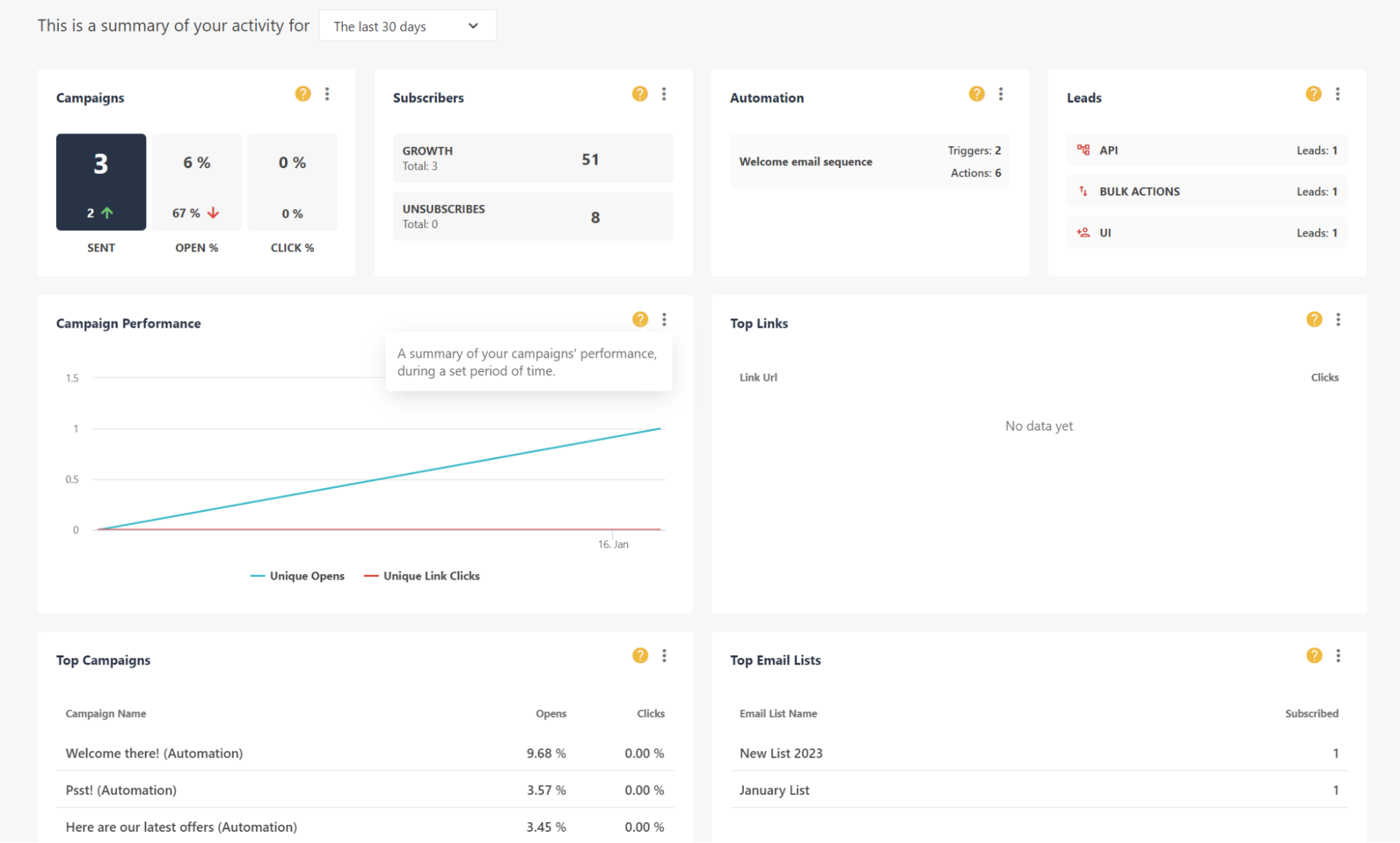
3. And provides several widgets showing your:
- Revenue Overview — summary of revenues based on completed and abandoned orders.
- Revenue Summary — total revenue generated for the selected date range.
- Revenue by Campaign Type — summary of revenues from campaigns and automations.
- Top Products — top ten purchased products based on total orders and revenues.
Moosend also lets you create custom reports by using widgets to display the data most relevant to you. It offers five types of widgets that provide valuable insights as charts, graphs, and tables, including:
- Senders,
- Campaigns,
- Mailing Lists,
- Growth Tools,
- and Website Analytics.
tinyEmail only offers basic pre-built reports.
tinyEmail helps you optimize your email marketing efforts by collecting data on all active campaigns.
It displays this data on the analytics dashboard using graphs, tables, and reports. The Performance trend is a line graph that shows how your campaign performed over its lifetime or within a set duration.

Meanwhile, the Deliverability report shows your inboxing rate — the percentage of emails delivered to those sent out. It also shows your suppression metrics, including the unsubscribe rate and email bounce rate.

Finally, the Engagement report helps you understand how your audience interacts with your email marketing campaigns. It provides metrics on opened emails as well as clicks on links within your emails.
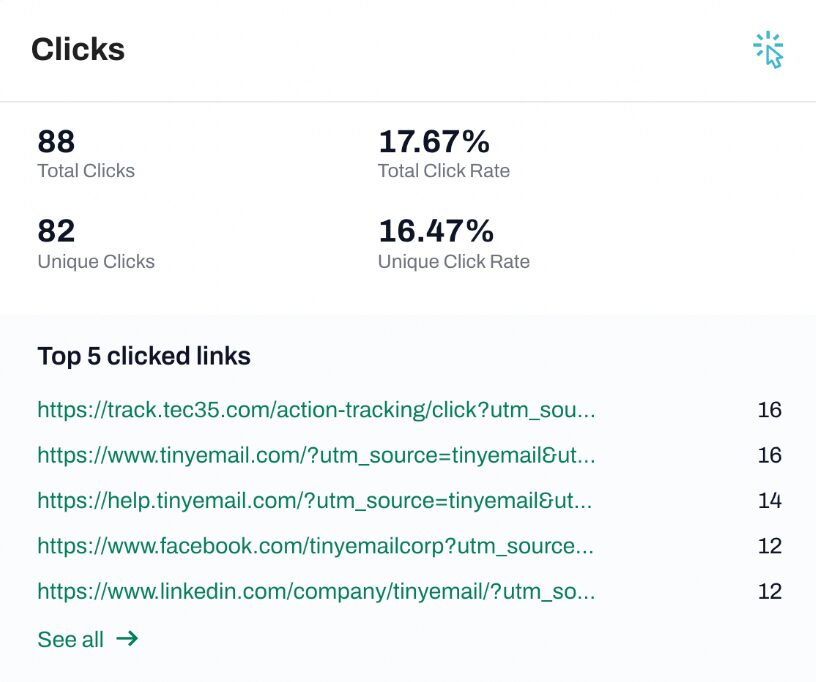
tinyEmail also provides metrics on your audiences and their sources.
It shows their growth on a graph, right on your main dashboard. And, you can assess the performance of a specific source based on core metrics, such as:
- click rate,
- open rate,
- unsubscribe rate,
- and number of subscribers.
It also offers per-subscriber metrics, showing their subscription status, opens and clicks, and update date.
Benchmark Email offers campaign reports and also includes list verification and A/B tests.
Benchmark Email'sSmart Sending technology intelligently predicts which contacts are least likely to open your email based on their previous engagement. It then skips these identified contacts from your email list so you can increase engagement and improve discoverability.
It also uses its List Verification feature to achieve a similar result.
First, it samples your contact list to ensure the contacts are valid. Then, depending on the results, it offers verification services, during which undeliverable emails are removed from the list.

To further optimize email delivery, Benchmark Email lets you run A/B tests on different variables within your emails. It determines success by the total number of Opens, Clicks, or Opens & Clicks, after which you can choose the winner to send to your contacts.
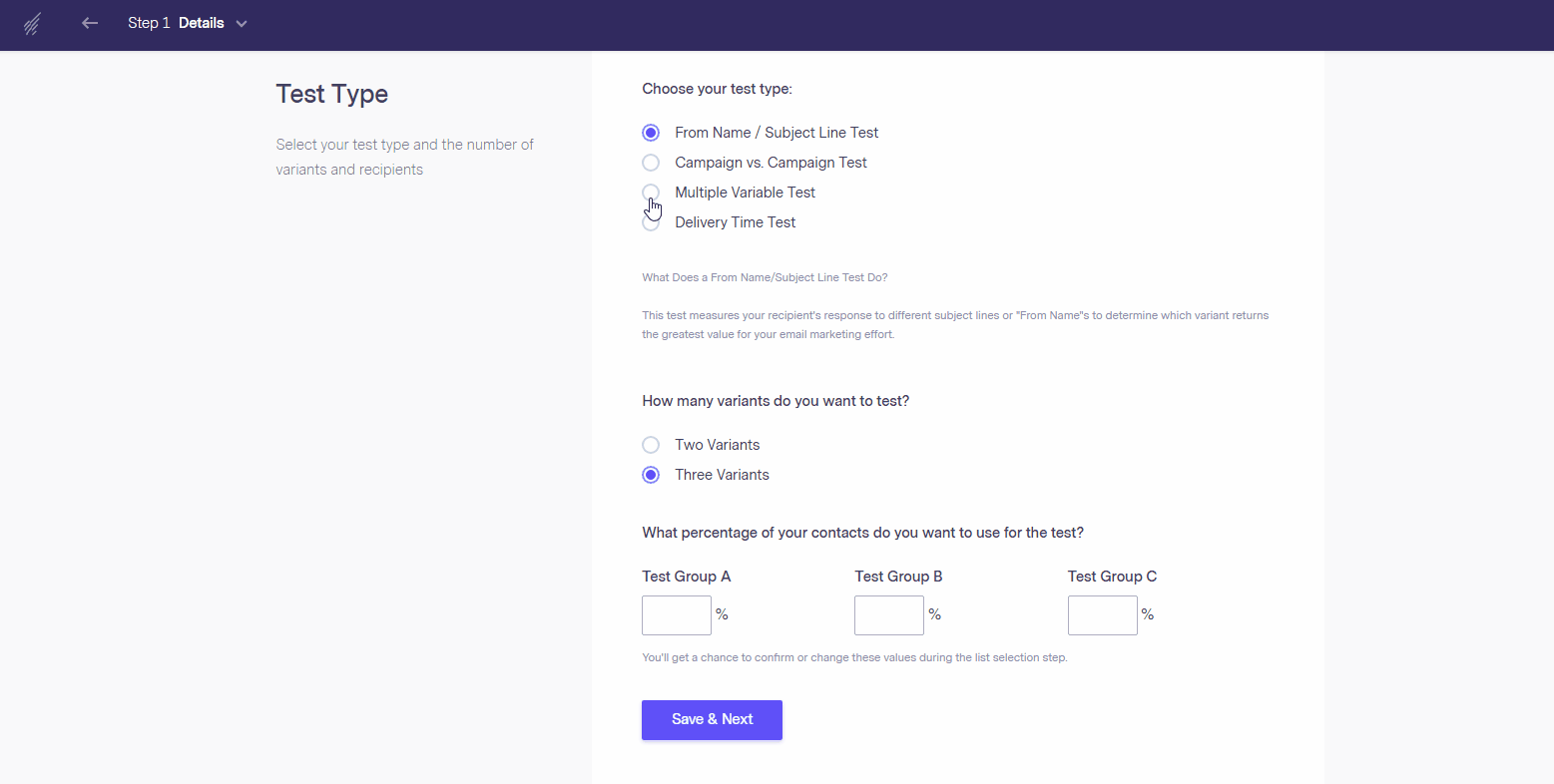
If you want total control over your sender reputation and email deliverability, Benchmark Email offers dedicated IPs at $28.95/month. Not only does a dedicated IP protect your reputation from being affected by other users, but you also get high-speed reliable sending.
Benchmark Email excels when it comes to reports as well.
It collects metrics on active email marketing campaigns, collecting unsubscribes, click interactions, hourly performance, and other metrics, allowing you to make data-driven decisions.

Unlike other platforms, it even shows your campaign performance by geolocation as well as reports on automations and customer complaints.
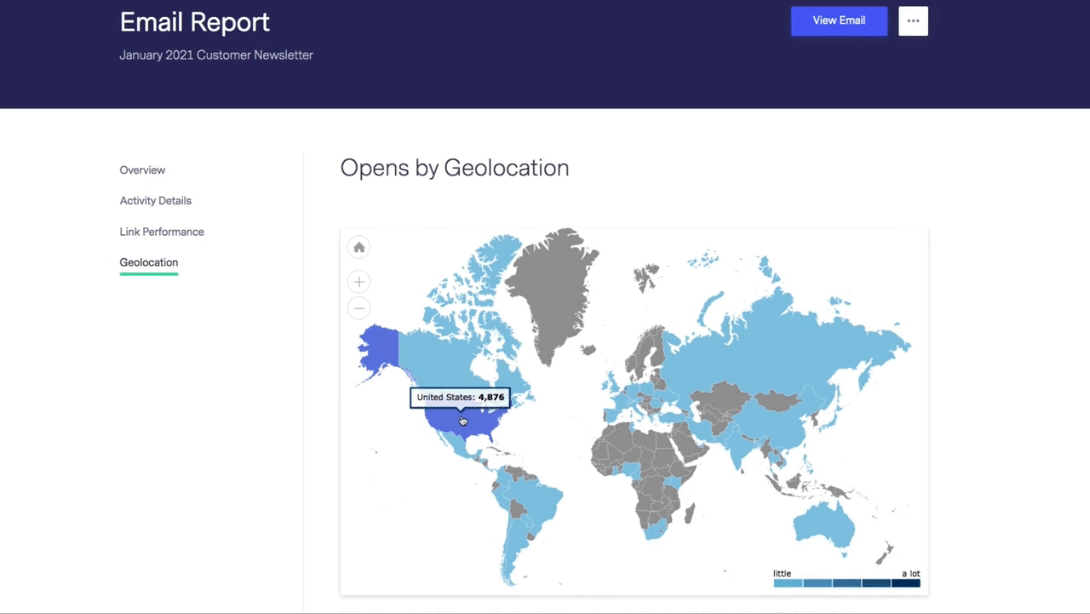
Winner: Moosend. It offers several types of reports and allows you to create custom reports that show only the information you need. It also includes AI-powered personalization tools for boosting engagement. While Benchmark Email doesn’t offer custom reports, it offers additional types of reports. It also provides email list verification. So, it's better for users who need an automated tool to optimize large mailing lists.
Moosend vs tinyEmail vs Benchmark Email: Marketing Automation
| Moosend | tinyEmail | Benchmark Email |
|---|---|---|
|
|
|
|
|
Simple and intuitive automation builder with branching paths and automation templates. |
Pre-built non-customizable automation templates. |
Email engagement automation plus advanced automation workflows. |
Moosend provides a simple and intuitive automation builder with templates.
Moosend lets you create custom automation workflows from scratch.
Unlike most automation builders, it supports multiple triggers, allowing your automations to start in multiple ways. And, you can execute multiple actions in a single workflow, such as:
- Send email campaign — sends an email campaign to your subscribers.
- Send a message to Slack — sends a Slack message to users or a channel.
- Ping me — sends an email notification to one or multiple designated email addresses.
- Trigger another automation — starts another active automation from the first automation.
- Add tags to members — assigns one or more tags to subscribers in your email list.
It also features branching paths with AND/OR conditions, random split flow, weather filters, and wait times. Moreover, you can merge branches back into a single path to avoid duplicating your work.

Moosend also provides automation templates, called Recipes, that serve as starting points for your designs. Rather than create an automation from scratch, you can choose one that best fits your marketing goals and edit it to your taste. Plus, you can save your edits as a new recipe.
tinyEmail offers pre-built automation templates, but you can’t customize them.
tinyEmail has a small but growing library of pre-built automation templates that perform specific tasks. However, you can’t customize them in-app. As an alternative, you can use the Support Request Channel to request a template that meets your specific need, forcing you to wait for the next app update to use your template.
Some of the pre-designed templates include:
- Welcome Series — automatically welcomes new subscribers.
- Abandoned Cart — recover abandoned carts and drive up sales.
- Thank You for Purchase — automatically send thank you email post-purchase.
Benchmark Email offers website tracking in its automated workflows.
Under its Automation Lite features Benchmark Email provides basic Contact List Automation, which is triggered by new contacts added, birthdays, anniversaries, and other annual events, or by an exact date.
To take it even further, Benchmark Email also offers Email Engagement Automation, which is triggered when a contact clicks a link or opens an email. You can set the email to send, a delivery time, and optional Google Analytics tracking. It also allows you to send multiple emails from a single automation.
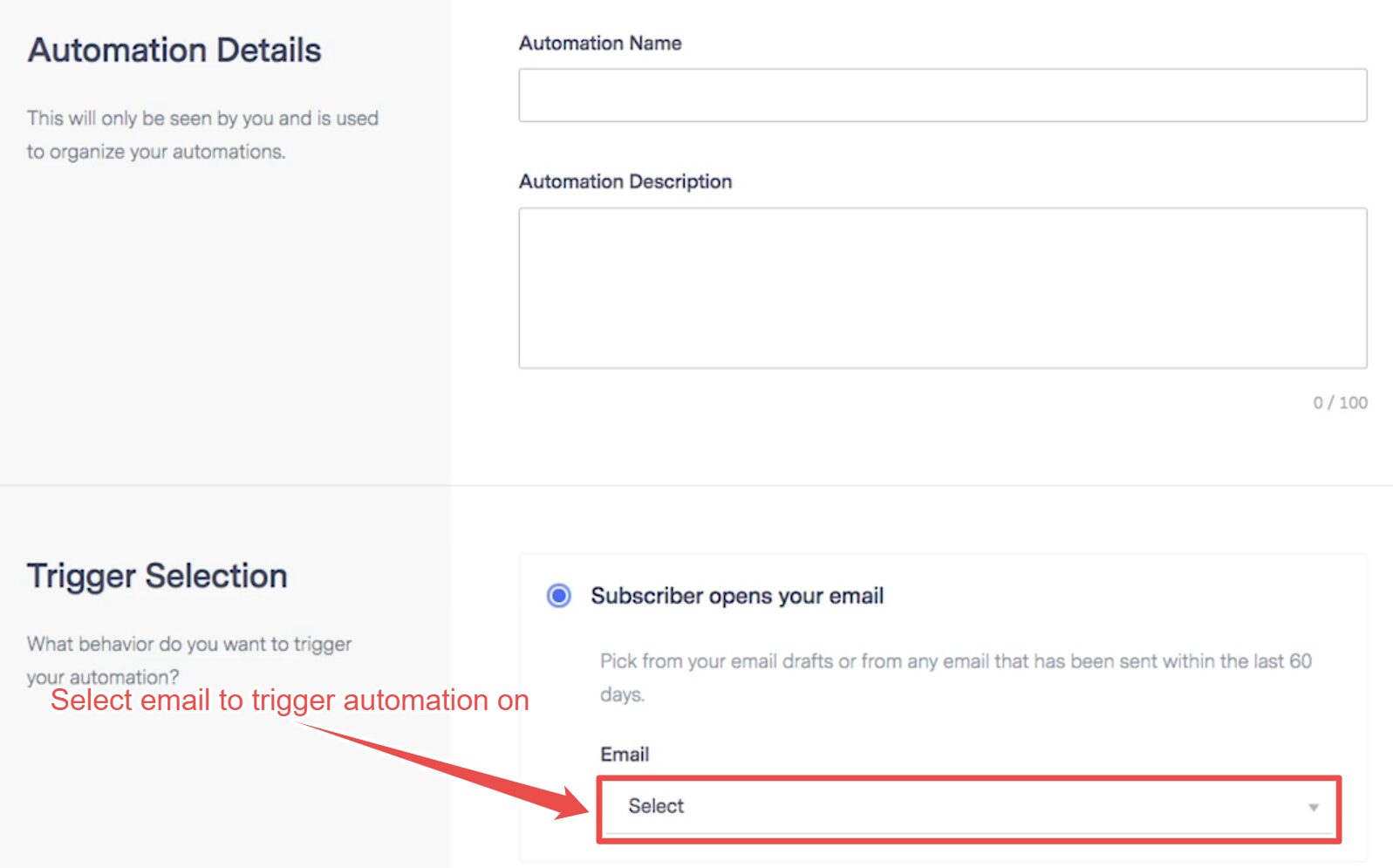
The Automation Pro feature unlocks a drag-and-drop canvas which allows you to create complex workflows. You can only have one trigger per automation, but Benchmark Email lets you chain multiple actions and conditions.

Unlike Moosend, Benchmark Email’s automation includes website tracking, allowing you to target contacts that have visited a webpage. All you need is a tracking code, and you can use website tracking as an automation trigger or condition.
Benchmark Email also offers several customizable automation templates, and it lets you save your custom automations as templates.

Winner: Benchmark Email’s offers advanced automated workflows with website and URL tracking. It also offers lots of templates and simpler email engagement automation for ease of use.
Moosend vs tinyEmail vs Benchmark Email: Pricing
| Moosend | tinyEmail | Benchmark Email |
|---|---|---|
|
|
|
|
|
Offers subscription and credit-based pricing. |
Only offers subscription-based pricing, but is free for Shopify users. |
Offers subscriptions, email send-based, and contact list size-based pricing. |
Moosend lets you choose between subscription- and credit-based pricing.
Moosendoffers a 30-day free trial, after which you can upgrade to a paid plan for unlimited emails.
The Pro plan starts at $9/monthand goes all the way up to $5,840/monthdepending on the number of subscribers in your account. The Enterprise plan adds an account manager, custom reports, dedicated IP, and more.
Moosend also offers credit-based pricing which charges you based on the number of emails you wish to send out. This pricing model costs $1 for every 1000 email credits, but you can only buy in $350, $500, $750, and $1000 bundles.
You also get key features, such as:
- landing pages,
- seasonal senders,
- subscription forms,
- reports and analytics,
- and unlimited subscribers.
tinyEmail only offers a subscription-based pricing model.
tinyEmail offers a free planthat’s automatically activated once the 7-day free trial elapses. This plan offers up to 15,000 emails for 500 subscribers. However, the features are limited to forms, emails, and automation.
The Standard plan ranges from $15/mofor 15,000 emails to $1500/mofor 1.5M emails.
It also gives you unlimited subscribers, premium templates, and limited customer segments. The Pro plan fully unlocks all features for $65/mo(15K emails) to $2100/mo(1.5M emails).
Since tinyEmail is primarily built for Shopify, it’s completely free to use for anyone with a premium Shopify account. You get all the same features as the Pro plan without the additional cost of sending emails.
Benchmark Email offers multiple pricing models that give you maximum flexibility.
Benchmark Email offers the standard subscription-based pricing model, starting with a free plan that includes 3,500 emails/mo for up to 500 contacts. The Pro plan costs between $15/mo and $499/mo based on the number of contacts in your account. It also unlocks landing pages, Automation Pro, and A/B testing.
Large-volume senders get the most value from Benchmark Email’s send-based pricing plan, which starts at $39/mo for 10,000 emails. Unlike Moonsend, which has a fixed cost for each email credit, Benchmark Email’s email credits progressively become cheaper as your email volume increases.

This plan includes add-ons that enhance your workflow.
For example, the List Verification add-on ensures that you have high-quality subscribers for just $3/1000 contacts. Also, you can host unlimited images, logos, and graphics for only $5/mo or for free with any Pro and Enterprise plan.
Finally, send-based plans only charge for the amount of emails you send.
Winner: Benchmark Email’s pricing offers the most flexibility, allowing you to choose the model that best fits your business and it offers considerably cheaper options than its alternatives at high email volume. Moonsendis more affordable for medium-volume monthly emails. tinyEmail is the most expensive option, but it is completely free for users with a Shopify account.
Moosend vs tinyEmail vs Benchmark Email: Pros & Cons
 |
||
|---|---|---|
| Moosend Pros | Moosend Cons | |
|
|
| |
|
|
| |
|
|
| |
|
|
||
 |
||
|---|---|---|
| tinyEmail Pros | tinyEmail Cons | |
|
|
| |
|
|
| |
|
|
| |
|
|
| |
 |
||
|---|---|---|
| Benchmark Email Pros | Benchmark Email Cons | |
|
|
| |
|
|
| |
|
|
||
|
| ||
Final Verdict: Moosend vs tinyEmail vs Benchmark Email
Moosend is best for marketers with small email lists, tinyEmail is best for Shopify users, and Benchmark Email is best for businesses with large lists.
| Moosend | tinyEmail | Benchmark Email |
|---|---|---|
|
Best for: Small marketing teams with medium-sized email lists. |
Best for: Users with a Shopify premium account. |
Best for: High-volume senders that need a straightforward email marketing platform. |
Moosend, tinyEmail, and Benchmark Email all offer similar tools and features, with subtle and not-so-subtle differences.
However, the biggest differentiator is their target audiences.
Moosend is best for marketers who send emails regularly to medium-sized email lists. tinyEmail was designed for Shopify users and thus works out best for them, especially. Meanwhile, Benchmark Email is designed to make the handling of large email lists and campaigns extremely easy for businesses and marketers alike.
Use Moosend if:
- You love using templates to create content.
- You need advanced reporting and analytics.
- You want maximum flexibility when creating forms.
Use tinyEmail if:
- You already have a premium Shopify account.
- You have some coding knowledge for full customization.
- You don’t need advanced automation tools.
Use Benchmark Email if:
- You need easy-to-use but powerful email marketing tools.
- You’re a business owner or marketer with large email lists.
- You want to save time creating emails with AI-generated content.
